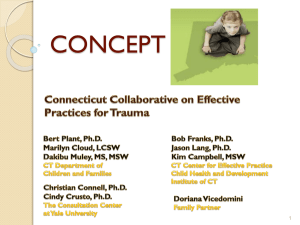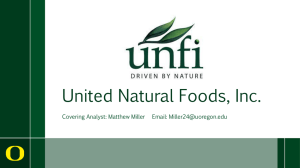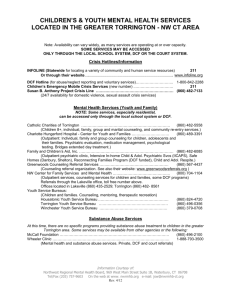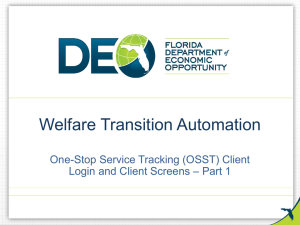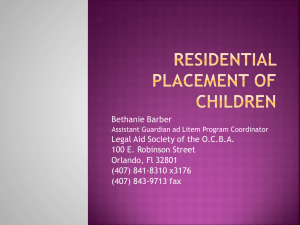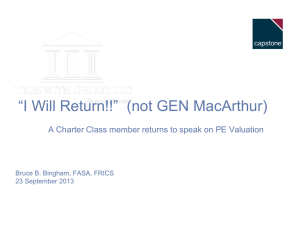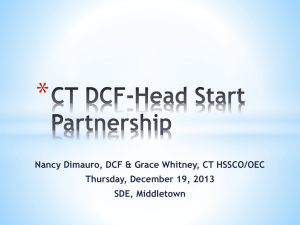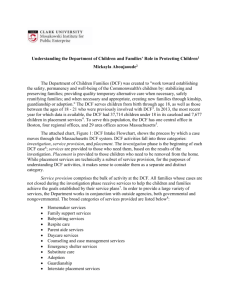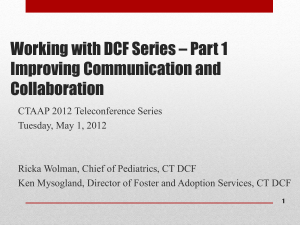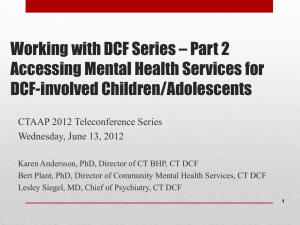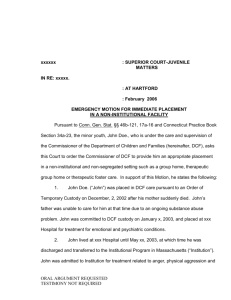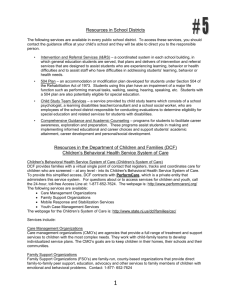Connecticut`s DCF-Head Start Partnership
advertisement
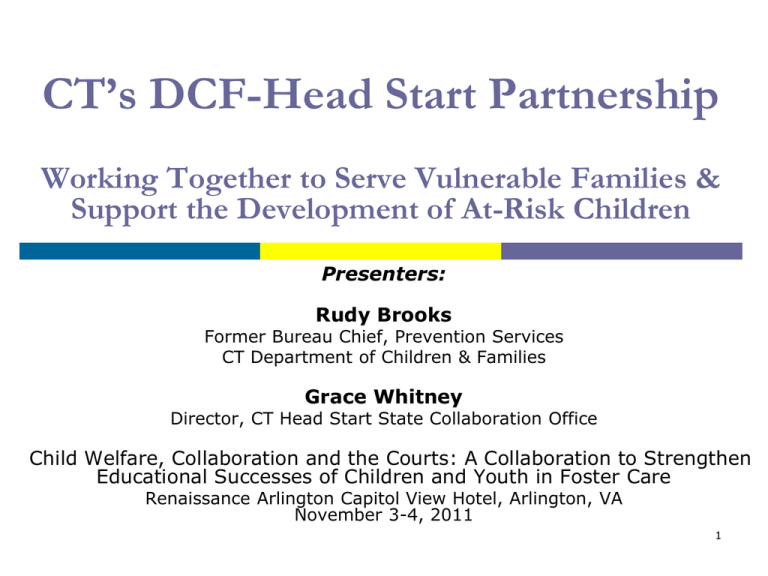
CT’s DCF-Head Start Partnership Working Together to Serve Vulnerable Families & Support the Development of At-Risk Children Presenters: Rudy Brooks Former Bureau Chief, Prevention Services CT Department of Children & Families Grace Whitney Director, CT Head Start State Collaboration Office Child Welfare, Collaboration and the Courts: A Collaboration to Strengthen Educational Successes of Children and Youth in Foster Care Renaissance Arlington Capitol View Hotel, Arlington, VA November 3-4, 2011 1 Why Should We Partner? Head Start/EHS and DCF often serve the same children Many Head Start/EHS children and families are at risk Great potential for identification and prevention Head Start/EHS is a natural environment for interventions to occur What Would the Benefits Be? Programs understand one another Establish regular procedures for working together Achieve continuity of care through case management Develop creative solutions for unique and difficult cases How Would Families Benefit? Families understand and access services Families feel supported Placements reduced and permanency increased for children Children access high quality ECE Children receive care from knowledgeable, nurturing adults working together Protocol for Working Together Section I: Identifying and Reporting Child Abuse and Neglect Section II: Communication on Open DCF Investigations Section III: Treatment Planning and Case Management Protocol for Working Together Section IV: Placement of Children Section V: DCF Referrals to Head Start/EHS Section VI: Agency Planning DCF-Head Start Partnership Phase 1 - Pilot 1999 1 DCF Areas & 3 Head Start/Early Head Start Created Protocol for Working Together Phase 2 – Ready Communities 2007 8 DCF Areas & 15 Head Start/Early Head Start Began quarterly facilitated meetings Phase 3 – Statewide Implementation 2009 6 DCF Areas & 11 Head Start/Early Head Start Added mental health, other early care, etc. Evaluation Quarterly Data Collection Building Trust and Partnership Maintaining On-going Collaboration Improving Services to Families “Stories” of interest Visits Average Number of Visits 7.00 6.00 5.00 4.00 DCF visits to HS 3.00 HS visits to DCF 2.00 Linear (DCF visits to HS) 1.00 Linear (HS visits to DCF) .00 Yearly Quarters "Getting to Know You" Meetings Average Number of Meetings 5.00 4.50 4.00 3.50 3.00 Meetings DCF attended 2.50 Meetings HS attended 2.00 1.50 Linear (Meetings DCF attended) 1.00 Linear (Meetings HS attended) .50 .00 Yearly Quarters Average Number of Committee Meetings Committee Participation 5.00 4.50 4.00 3.50 3.00 DCF staff on HS committees 2.50 2.00 HS staff on DCF committees 1.50 Linear (DCF staff on HS committees) 1.00 Linear (HS staff on DCF committees) .50 .00 Yearly Quarters Referrals Average Number of Referrals 14.00 12.00 10.00 8.00 HS referrals to DCF 6.00 DCF referrals to HS 4.00 Linear (HS referrals to DCF) 2.00 Linear (DCF referrals to HS) .00 Yearly Quarters DCF-Head Start Partnership & Collaboration Needs Assessment No working Relationship Cooperation Coordination Collaboration (exchange info/referrals) (work together) (share resources/ agreements) (little/ no contact) 2008 14% 11% 36% 39% 2009 0 0 8% 92% 2010 0 6% 0 94% Results Simplify/standardize referral processes and intentional enrollment of DCF-involved children, including foster care, into Head Start Align Treatment Plan/Family Partnership Agreement Connect mental health supports, housing supports, other early care Modifying DCF LINK data system to help identify and serve children under five The Collaborative Process 1. It must be meaningful to you! 2. Balancing Process with Product 3. Mental Models 4. The Collaborative Path Getting to Know One Another as Organizations Common Ground Improving Outcomes for Children Stage 5: Going to Scale •Adapt and expand prototype •Deepen collaborative culture •Institutionalize processes Stage 4: Taking Action •Implement new processes •Collect data •Evaluate progress-make course corrections Stage 3: Developing a Plan Stage 2: Building Trust •Formalize interagency relationships •Define service delivery processes •Develop technical tools •Get to know one another •Build cooperative relationships •Establish shared goals Stage 1: Getting Together •Commit to Collaboration •Involve the right people •Decide to act Team Self-Assessment Where are we now? Have there been changes for which we need to repeat earlier steps to get everyone up to speed? Are there others we need to invite to our table? What are some logical next steps to include on our Goal Sheet? Do we need any additional supports? What’s Worked for Us..... Ongoing commitment from and access to all levels of both agencies Critical importance of support at the top! A process that promotes statewide goals yet respects local differences and needs Opportunities to share accomplishments with and learn from other communities What’s Worked for Us..... Community Leaders Federal/State Leaders Local Meetings Strategic Facilitation Membership Lists Meeting Supports Quarterly Data Sheets Data, Data, Data Quarterly Goal Sheets Policy/Practice Change “Community NEWS” New Resources
